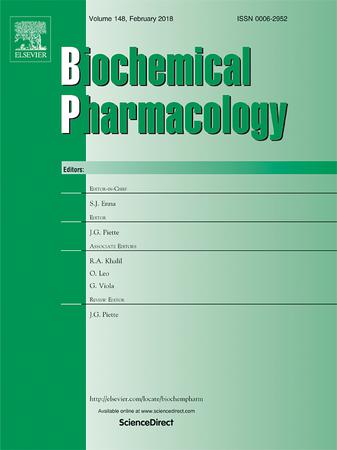一种非杀菌的富含甘氨酸的肽通过激活TLR4/MAPK/NF-κB通路促进小鼠皮肤伤口愈合。
IF 5.3
2区 医学
Q1 PHARMACOLOGY & PHARMACY
引用次数: 0
摘要
虽然从原核生物到真核生物,富含甘氨酸的多肽的抗菌特性都已得到了很好的描述,但它们在皮肤伤口愈合中的作用仍然鲜为人知,尤其是非杀菌性的富含甘氨酸的多肽。本文从树蛙 Zhangixalus smaragdinus 的皮肤中鉴定出了一种新型富含甘氨酸(46.5%)的多肽(Smaragin,SRGSRGGRGGRGGGRGGRSGSGSSIAGGGSRGSRGSGGSQYA)。与其他富含甘氨酸的肽不同,Smaragin 在体外没有显示出抗菌活性,但能显著促进小鼠全厚真皮伤口的愈合。与其他促进伤口愈合的肽相比,Smaragin 不会直接影响角质形成细胞、血管内皮细胞和成纤维细胞的增殖和迁移。不过,在受伤后 0.5 天,它明显增加了伤口处吞噬细胞的浸润。Smaragin 对吞噬细胞没有直接的趋化吸引作用,但它能刺激巨噬细胞分泌趋化因子 CXCL1 和 CXCL2,从而间接促进吞噬细胞、角质形成细胞和血管内皮细胞的迁移。此外,Smaragin 还能促进伤口处的巨噬细胞从促炎 M1 型极化为抗炎 M2 表型,这与血管生成活性有关。正如预期的那样,血管生成最常见的分析标志物 CD31 显示血管网络面积显著增加。随后的研究发现,斯玛拉金通过 TLR4/MAPK/NF-κB 通路促进了趋化因子水平和巨噬细胞的极化,从而增强了吞噬细胞的数量以及伤口处表皮和血管的再生,从而加速了小鼠皮肤伤口的愈合。这些发现凸显了富含非杀菌甘氨酸的多肽的皮肤愈合特性,并显示了Smaragin作为开发有效伤口愈合疗法的候选物质的潜力。本文章由计算机程序翻译,如有差异,请以英文原文为准。

A non-bactericidal glycine-rich peptide enhances cutaneous wound healing in mice via the activation of the TLR4/MAPK/NF-κB pathway
Although the antibacterial properties of glycine-rich peptides from prokaryotes to eukaryotes have been well characterized, their role in skin wound healing remains poorly understood, especially non-bactericidal glycine-rich peptides. Herein, a novel glycine-rich (46.5%) peptide (Smaragin, SRGSRGGRGGRGGGGRGGRGRSGSGSSIAGGGSRGSRGGSQYA) was identified from the skin of the tree frog Zhangixalus smaragdinus. Unlike other glycine-rich peptides, Smaragin showed no antimicrobial activity in vitro but significantly enhance wound healing in full-thickness dermal wounds in mice. In comparison with other wound healing-promoting peptides, Smaragin did not directly affect the proliferation and migration of keratinocytes, vascular endothelial cells, and fibroblasts. However, it notably increased phagocytes infiltration at the wound site by 0.5-day post-injury. Smaragin was not a direct chemoattractant for phagocytes, but it stimulated macrophages to secrete chemokines CXCL1 and CXCL2, which indirectly enhanced the migration of phagocytes, keratinocytes and vascular endothelial cells. Moreover, Smaragin promoted the polarization of macrophages from a pro-inflammatory M1-type to an anti-inflammatory M2 phenotype at the wound, which is associated with angiogenic activity. As expected, CD31, the most common analyzed marker of angiogenesis, showed a significant increase in vascular network area. Subsequent studies revealed that Smaragin promoted the chemokine level and polarization of macrophages via the TLR4/MAPK/NF-κB pathway, which enhanced the number of phagocytes and the regeneration of the epidermis and blood vessels at the wound, thereby accelerating skin wound healing in mice. These findings highlight the skin healing properties of non-bactericidal glycine-rich peptides and display the potential of Smaragin as a promising candidate for developing effective wound healing therapies.
求助全文
通过发布文献求助,成功后即可免费获取论文全文。
去求助
来源期刊

Biochemical pharmacology
医学-药学
CiteScore
10.30
自引率
1.70%
发文量
420
审稿时长
17 days
期刊介绍:
Biochemical Pharmacology publishes original research findings, Commentaries and review articles related to the elucidation of cellular and tissue function(s) at the biochemical and molecular levels, the modification of cellular phenotype(s) by genetic, transcriptional/translational or drug/compound-induced modifications, as well as the pharmacodynamics and pharmacokinetics of xenobiotics and drugs, the latter including both small molecules and biologics.
The journal''s target audience includes scientists engaged in the identification and study of the mechanisms of action of xenobiotics, biologics and drugs and in the drug discovery and development process.
All areas of cellular biology and cellular, tissue/organ and whole animal pharmacology fall within the scope of the journal. Drug classes covered include anti-infectives, anti-inflammatory agents, chemotherapeutics, cardiovascular, endocrinological, immunological, metabolic, neurological and psychiatric drugs, as well as research on drug metabolism and kinetics. While medicinal chemistry is a topic of complimentary interest, manuscripts in this area must contain sufficient biological data to characterize pharmacologically the compounds reported. Submissions describing work focused predominately on chemical synthesis and molecular modeling will not be considered for review.
While particular emphasis is placed on reporting the results of molecular and biochemical studies, research involving the use of tissue and animal models of human pathophysiology and toxicology is of interest to the extent that it helps define drug mechanisms of action, safety and efficacy.
 求助内容:
求助内容: 应助结果提醒方式:
应助结果提醒方式:


